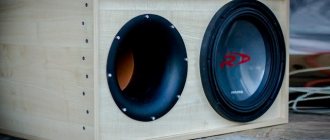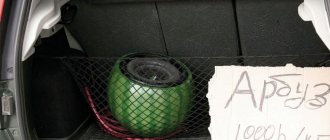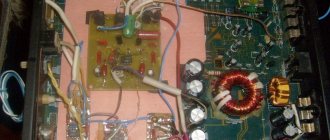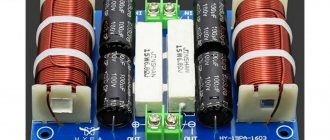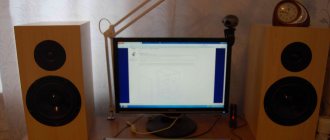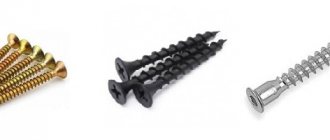The formula for automotive happiness is a cool car, beautiful girls and powerful sound. You can achieve a sound that penetrates to the bones only by installing subwoofer for car.
- Installing a subwoofer in a car
- Subwoofer connection diagram
It is designed to reproduce low frequencies in the audio range. It is these frequencies that the human body perceives with all organs.
Features of low-frequency signal reproduction
Acoustics is a complex science.
She studies the reproduction, propagation, and absorption of sound signals, taking into account the peculiarities of their perception by humans.
When designing concert halls and theaters, the main designer is an acoustic engineer. It calculates the shape, volume and other parameters of the area where the listeners are located.
From an acoustics point of view, a car is far from an ideal place for sound:
1. The car interior is made using various materials that reflect and absorb sound waves in different ways. Plastic interior parts and tin housings are especially “harmful” to vibrations.
Therefore, before installing powerful subwoofers, car owners often perform good sound and noise insulation.
2. There are many relatively small elements in the cabin (steering wheel, rear view mirror, gadgets) that are involved in signal re-reflection.
3. The seat upholstery, as well as the passengers, absorb sound perfectly. In this case, the softness of the sound benefits, but its strength (sound pressure in scientific terms) decreases.
4. No experienced acoustician can accurately calculate how sound will propagate inside the cabin.
What are the sound features of subwoofers?
A car subwoofer is designed to reproduce the low-frequency component of the sound spectrum.
The sound that is perceived by the human ear ranges from 20 Hertz to 18 kilohertz. Some sources indicate a frequency of 20 kHz, but such a high frequency can only be heard by a young organism with good hearing.
Subwoofers are designed in such a way that they emit a signal in the range from several Hertz to several hundred Hertz.
The lower the frequency, the longer the sound wavelength. Therefore, the size of the diffuser speakers is larger compared to the mid-frequency and high-frequency emitters of the acoustic system.
Accordingly, the size of the housing in which the subwoofer speaker is installed increases.
A useful property of long waves (or low frequencies) is the ability to bend around small objects. That is why, when a car with a good subwoofer drives by, its sound mainly catches your ears. The high-frequency signal penetrates poorly outside the vehicle.
The human body perceives low-frequency signals through its internal organs. This is not always useful. An infrasound signal at a frequency of 7 Hertz can cause rupture of the diaphragm (the area between the lungs and the digestive system), resulting in death.
In addition, a high-power low-frequency signal causes a state of anxiety and panic.
Horror films often use this technique to further influence the viewer's psyche.
We choose a budget subwoofer with a box. Video:
Food truck trailers on wheels: a new business direction in Russia
- equivalent volume;
- acoustic resonance frequency in open space conditions;
- maximum noise power;
- diffuser diameter;
- speaker quality factor;
- electrical quality factor;
- mechanical quality factor;
- impedance of your speaker.
If you are using standard speakers, then some parameters are already set and do not need to be changed. You can search for the necessary information through the manufacturer’s website, find data on the Internet and see what is indicated on the packaging. If you ordered some strange speaker from China, you may not be able to find information on it.
In this case, the key parameter is considered to be the quality factor of the speaker, which is designated as Qts. This parameter describes the performance of the speaker at resonant frequencies. When you enter all the specified parameters, the program will give you one type of box for the sub as an answer. There are 3 options in total, each of which has its own strengths and weaknesses.
The boxes are:
- standard closed;
- bandpasses;
- bass reflexes.
The first option is the simplest in terms of manufacturing and creating a project. But the efficiency indicators are low. It is also important to comply with strict requirements for the tightness of the box.
The other two are better in terms of sound, but making them yourself is extremely problematic.
Final design stage
Working through the program, you will need to create a new project for your future sub.
The sequence of operations is approximately as follows:
- First, a new speaker is created, after which its parameters will need to be loaded into the database;
- Next, a project is created based on the box that you chose or the program recommended to you;
- To complete this step, you will need to follow the previously described procedures again;
- Design includes making changes to the box, adjusting the frequency and other parameters.
By changing the parameters, the graph with frequencies will change in parallel. You should try to make sure that at 25 to 35 Hz the graph crosses the -3 dB line, then follows the line to 0 dB, and then moves downward at 150 to 200 Hz.
Types of subwoofers, main characteristics
The main radiating element of the subwoofer is the speaker. Its main characteristics and parameters:
- geometric dimensions;
- shape (round, oval);
- winding resistance (2, 4, 6 or 8 Ohms);
- maximum power;
- rated power;
- reproduced frequency band;
- uneven frequency response;
- geometric dimensions of the magnet;
- materials of the diffuser, suspension, frame.
In order to drive a high-power speaker, a separate amplifier for the subwoofer is required. If the amplifier is built into the subwoofer housing, such a device is called active. A passive subwoofer does not have a built-in amplifier.
Amplifiers are used in two main classes: AB and D. Class AB (analog) amplifiers have a low nonlinear distortion factor. These distortions change the shape of the signal.
If they have a value of more than 0.2%, the human ear perceives the sound in a “metallic” or “wheezing” format.
The disadvantage of class AB is its low efficiency. If the power of such an amplifier is 100 watts, then it will dissipate approximately the same amount in the form of heat at the output stages. They need to be cooled.
Class D amplifiers have high efficiency. Nonlinear distortion coefficient – up to 1%. For music lovers this is not a thrill.
The subwoofer box is used in the following versions:
1. Closed box. The simplest type of case. Despite this, with proper execution and the use of high-quality fillers, its sound can be softer compared to other types.
A significant drawback is the low efficiency. Part of the sound energy is absorbed inside the closed box before reaching the consumer.
2. Box with bass reflex. A bass reflex is a specially designed hole or slot in the housing with reflector elements inside the box (sound tunnel).
The bass reflex increases the efficiency and reduces the load on the speaker.
3. Bandpass loudspeaker (BANDPASS). Bandpass 4 order has an internal speaker, on both sides of which there are sound tunnels designed for different frequency bands.
Designing such a subwoofer is extremely difficult. The resulting effect: almost ideal frequency response and maximum efficiency. Manufacturing of the design is available only to car audio professionals.
There are two other special types of subwoofers: boxless and compact. Frameless subwoofers feature a low-frequency speaker mounted on a reflector made of special plywood.
A compact cabinet subwoofer under a car seat has low power. Its effectiveness is enhanced by proximity to the listener.
How to increase the rigidity of the box?
- The first, the simplest and most obvious. This is the thickness of the material, the thicker the material, the greater the rigidity. When making a subwoofer, we recommend using materials of at least 18 mm, this is the golden mean. If your subwoofer has a power of more than 1500w RMS, then it would not be superfluous to choose a material thickness of 20 mm or more. If you have difficulty finding thick-walled materials, you can use the following recommendations.
- An option that will add rigidity to your box is to make a double front wall. That is, the front part in which the speaker is installed. This part of the subwoofer is most subject to stress during operation. Therefore, having a material width of 18 mm, making the front wall double we get 36 mm. This step will significantly add rigidity to the box. You should also do this provided that your subwoofer has an RMS (rated power) of more than 1500w. If you have a subwoofer with a lower power, for example, 700w, the front wall can also be made double. This makes sense, although the effect will not be very large.
- Another tip is to use spacers inside the subwoofer to add extra rigidity. This works especially well when the subwoofer has a large volume. Let's say you have two 12-inch subwoofers (speakers) in a box. In the middle, the rigidity of the box will be the smallest due to the large area. In this case, it would not hurt you to strengthen the structure and install a spacer in this place.
That's all we wanted to tell you about materials for the subwoofer. If this article helped you, please rate it out of five below.
Do you want to try to calculate the box yourself? Our article “Learning to count a subwoofer box” will help you with this.
Subwoofer models
Subwoofers are produced by many manufacturers: from the giants of radio construction to newly emerging companies that have tightly occupied this niche. Let's give a few examples.
The Herts DBX 30.3 passive subwoofer has excellent sound quality, a maximum power of 1000 Watts, a nominal power of 250 Watts. Speaker diameter 12 inches (about 30 cm). The body is a closed box. Resistance 4 Ohms. This subwoofer is suitable for high-quality reproduction of frequencies in the range from 28 to 300 Hz. For boosting, you need to use a high-quality, powerful amplifier.
The active subwoofer in the Pioneer NS-WX210A car with a maximum power of 150 Watts has a resistance of an 8-inch speaker of 2 Ohms, a strontium magnet, a polypropylene diffuser, and a reproducible frequency band from 50 to 125 Hertz. Such a device is sufficient for dubbing a middle-class car.
The FOCAL DSA 500 RT car subwoofer has a rated power of 165 Watts. This power is enough to sound a large car or minibus. A Band-pass type box with high dynamic characteristics is used. This was reflected in its cost (up to 49,000 rubles). In addition to the main low-frequency channel, the subwoofer has a built-in front two-way amplifier. If the car radio has a low output power, you can organize a 2.1 system without additional amplifier.
Good subwoofers and speakers for them are also produced by manufacturers JL AUDIO, Kiks, FSD, Phantom, Audison.
How to select oil by car brand without overpaying
- 6-inch. Used as sources of mid-bass when combined with large subs;
- 8-inch. Well suited for those who need front bass;
- 10-inch. Suitable for speakers with an internal volume of 15-20 liters;
- 12-inch. They produce excellent sound quality, but the box will have a volume of at least 25 liters;
- 15-inch. Incredibly powerful bass, but the case takes up a minimum of 60 liters. Or even all 90.
Before assembling your flat or surround sub, be sure to think about choosing the voice coil resistance. One simple rule applies here. The lower the resistance of the amplifier, the higher the power parameter will be.
The mistake of many is choosing devices with a minimum value. If you place a subwoofer with similar resistance under a seat or anywhere else, the sound quality will suffer greatly. It is optimal to choose about 2-4 ohms. But it’s better to refuse 1-2 Ohms.
As for power, specialists and ordinary car enthusiasts do not have a consensus on this matter. But I can say one thing for sure. It is optimal when the power of the selected speaker slightly exceeds the power parameters of the amplifier used. We must not forget that almost all systems are not designed to operate for a long time and at maximum power. Gradually, in this mode, the sound quality will decrease and various distortions will appear.
Choose wisely, keeping in mind that all this equipment will have to be installed somewhere. It would be correct if the built-in subwoofer does not disturb the interior space, and also does not become an obstacle in the luggage compartment of your VAZ 2107 or any other car.
Connecting a subwoofer
Before connecting the subwoofer to your car, you need to read the installation instructions included in the package. Active subwoofers can have a low-level input, a high-level input, or two inputs simultaneously.
The high-level input involves connecting the subwoofer directly to the output of the head unit (car radio) to the speakers.
If such an output is connected to a low-level input (input signal amplitude no more than 1 Volt), the high-voltage signal can damage the input channels of the built-in amplifier.
In the best case, wheezing will be heard from the speakers even at low volume of the car radio.
The location for installing the subwoofer for single-volume cars (hatchback, station wagon, minivan) is better to choose the trunk. In small sedans it is better to use a compact subwoofer.
When connecting, special attention should be paid to the connection conductors. Wires for the subwoofer should be purchased from specialized stores.
Low-level input conductors are made with coaxial shielding to prevent extraneous low-frequency interference, the source of which can be the vehicle's electrical equipment, ignition system, foreign cars, electric vehicles.
The conductors connecting the output of the amplifier (car radio) and the passive subwoofer are also special, made of copper using a special technology.
It is necessary to accurately calculate the length of the conductors. A large margin of length “just in case” is undesirable. The extra length creates additional resistance.
In passive subwoofers, increasing the resistance reduces the output power. For active devices, a long, spooled signal wire may increase noise.
Installing a subwoofer in a car
The installation site must be prepared. It should have maximum flatness.
Do not install the subwoofer on an uneven surface. This may create additional rattling noise.
Installation on metal elements or surfaces without additional padding should also be avoided.
You can use special mats, including rubber or foam rubber (it needs to be replaced periodically).
How to connect an active subwoofer in a car using power?
The power supply circuits of the active subwoofer should also be connected with special conductors.
They must have a cross-section that can withstand the maximum current in the subwoofer power circuit. Example of approximate calculation:
- Rated power P according to the passport data is 200 Watt.
- The resistance of the R speaker winding is 2 Ohms.
- Maximum current I = SQRT (2*P/R) = about 15 Amps
Typically, a two-fold current reserve is chosen. It is believed that 1 square millimeter of copper wire cross-section allows a current of 4 Amperes.
Divide 15 by 4, it turns out that the cross-section of the copper conductor must be at least 4 square meters. mm. It is better to choose a copper stranded special wire with a cross-section of 6 - 8 square millimeters.
At the same time, you should purchase a 30 - 50 Ampere fuse. It is sold together with mounting hardware and a connection connector. Install the fuse no further than 30 centimeters from the positive terminal of the battery.
Power supply via the negative bus can be generated from any (preferably standard) place in the metal area of the body.
To do this, it must be thoroughly cleaned, then connected to the negative power cable of the active subwoofer.
The cross-section of the negative wire is similar to the cross-sectional area of the positive wire. It is better to organize the negative power supply with a conductor in black PVC insulation, and the positive one in red. The negative bus can be laid with a bare conductor.
What is the easiest way to connect an active subwoofer in a car to a radio? Video:
How to make a subwoofer with your own hands?
Some car enthusiasts make their own subwoofers. No special knowledge is required for this. The main thing is to be able to work with your hands and have experience in electrical installation work.
For manufacturing, it is better to choose a closed box type passive subwoofer model.
As a speaker, you should choose a round (not oval) type device. It's easier to cut a hole for it. The rated power of the speaker is selected based on the output power of the head unit (car radio, amplifier).
The typical value of the rated power of a radio is no more than 40 watts per channel. It is better to choose the speaker power with a twofold margin. This will not add power, but the sound will be softer.
You should also pay attention to the speaker impedance. It must match the load resistance of the amplifier or radio.
If an additional audio amplifier is used, it may have different allowable load impedances. It should be borne in mind that the lower the resistance of the speaker, the easier it is to swing it.
But this increases the load on the amplifier. For Class D amplifiers, you can safely choose speakers with a resistance of 2 Ohms.
It is better to connect four-ohm speakers directly to the car radio output.
You should also pay attention to the material of the diffuser (preferably polymaterials) and magnet.
The size of the speaker is determined based on the type of car body and the availability of free space. Theoretically, the larger the diameter of the diffuser, the greater the sound pressure it can create and the more solid it will sound.
Next, the subwoofer box is calculated. Previously, the calculation of the subwoofer box was performed using a calculator.
Now there are many programs for calculating boxes and online resources. They are not difficult to master; the interface is quite simple.
These calculations are not always performed correctly (especially online services).
They often work the other way around: you enter the dimensions of the box, and the service gives you the frequency response. Services and programs provide more or less plausible results:
https://reaudio.com/info/RE_box_calculator.php
BassBox 6
Having experience in making closed boxes, you can begin making bass reflex boxes.
Power Port
Most programs are not adapted to the Russian interface.
When making boxes you should:
- saturate the fastener installation sites with glue;
- cut holes using special attachments on a drill; other methods lead to destruction of the surface;
- protruding edges must be cleaned;
- coat wooden materials with special impregnation and nitro-varnish (to protect against dampness);
- Upon completion of work, cover the product with carpet.
Subwoofer connection diagram
Most subwoofers, including passive ones, have their own electrical circuit. It is necessary so that the signal from the amplifier or car radio to the speaker does not contain “unnecessary frequencies”. Unnecessary frequencies refer to mid- and high-frequency audio frequencies.
If they are sent to the speaker, the efficiency will decrease and distortion is possible. Special frequency filters (crossovers) are built into amplifiers and good car radios.
However, a good passive low-pass filter (usually containing a set of capacitors and inductors) greatly improves sound quality.
Calculation programs:
- Audiotester v2.2
- JBL-SpeakerShop
If you have no experience in electrical installation work, winding inductors, or measuring instruments, it is better to purchase an assembled filter (crossover).
Installation of gas cylinder equipment (LPG) on a car. - there is more useful information here.
On Chinese sites it is inexpensive, for example:
https://ru.aliexpress.com/item/Pure-Bass-Audio-Professional-Subwoofer-Frequency-Divider-Speaker-Crossover-Filter/32711849085.html
You will be interested in this article - Installing an alarm system with auto start yourself.
Subwoofer design
The next step will be to create a project for the future subwoofer. Before assembling the case, it is recommended to perform some calculations. You can see something in the video, study the experience of making subs by other car enthusiasts.
But it’s still right to make a project specifically tailored to your speaker and car parameters. There is even a special almost professional program for such purposes. It's called Win ISD. Some parameters are entered into it, as a result of which you get a project for the optimal subwoofer.
You should know about:
How to set up a subwoofer in a car?
Once connected correctly, the subwoofer starts working immediately. If the active device has a level control, you need to configure it.
- To do this, set the regulator to the minimum position.
- Next, increase the level of the head unit to the maximum.
- Then the position of the regulator is gradually increased until the moment when frequency or nonlinear distortions appear.
- Slightly reduce the position of the regulator, fix it or mark it with a marker.
Within small limits, shifting the position of the subwoofer within the specified location helps change the acoustic picture of the cabin.
You can check the sound pressure level in different places in the cabin using your smartphone. To do this, install the “Noise Meter” program from the Play Market on it.
